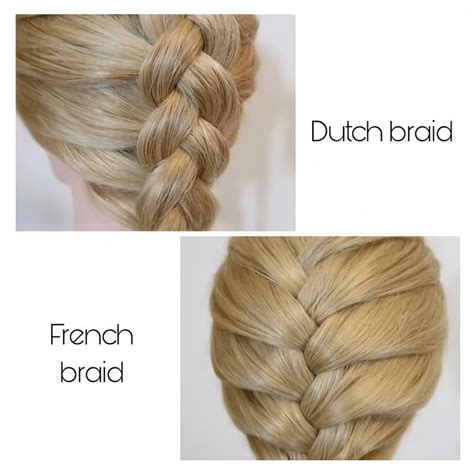Braiding is an art form that has been practiced for centuries. From simple plaits to intricate updos, there are countless ways to style your hair with braids. Two of the most popular braiding techniques are Dutch braids and French braids. Both create a beautiful, elegant look, but there are some key differences between the two.

Techniques
* Dutch braids: Dutch braids are created by crossing the strands of hair over each other, instead of under, as in French braids. This creates a raised, textured look.
* French braids: French braids are created by crossing the strands of hair under each other, resulting in a flat, smooth look.
Appearance
* Dutch braids: Dutch braids have a more voluminous, raised appearance compared to French braids. They can be braided tightly or loosely, depending on the desired look.
* French braids: French braids have a flat, close-to-the-head appearance. They are typically braided tightly to create a secure hold.
Applications
* Dutch braids: Dutch braids are versatile and can be worn in a variety of styles, including updos, half-updos, and braids on the sides.
* French braids: French braids are often used to keep long hair out of the face or to create a more formal look. They are popular for wedding hairstyles and other special occasions.
Difficulty
* Dutch braids: Dutch braids can be slightly more difficult to learn than French braids, as they require more precision in crossing the strands over each other.
* French braids: French braids are relatively easy to learn and can be mastered with practice.
Dutch and French braids can be used in a wide range of applications, including:
| Application | Dutch Braids | French Braids |
|---|---|---|
| Everyday wear | ✅ | ✅ |
| Special occasions | ✅ | ✅ |
| Updos | ✅ | ✅ |
| Braids on the sides | ✅ | 🚫 |
| Ponytails | 🚫 | ✅ |
- Braiding too tightly: This can lead to hair breakage and headaches.
- Not securing the braid properly: Loose braids can easily come undone.
- Using too much hairspray: Hairspray can make braids stiff and crunchy.
- Braiding wet hair: Wet hair is more prone to breakage and tangling.
- Not brushing your hair before braiding: Brushing your hair helps remove tangles and makes braiding easier.
Dutch Braids:
1. Divide your hair into three equal sections.
2. Cross the right section over the middle section.
3. Bring the left section over the new middle section (which is the old right section).
4. Repeat steps 2 and 3, adding small sections of hair from the sides as you go.
5. Secure the braid with an elastic band.
French Braids:
1. Divide your hair into three equal sections.
2. Cross the left section over the middle section.
3. Bring the right section over the new middle section (which is the old left section).
4. Repeat steps 2 and 3, adding small sections of hair from the sides as you go.
5. Secure the braid with an elastic band.
There are countless variations on Dutch and French braids, including:
- Inverted Dutch braids: Created by crossing the strands under each other, opposite of Dutch braids.
- Pancakes braids: A flat, wide braid created by pulling the strands apart after braiding.
- Fishtail braids: A narrow, intricate braid created by dividing the hair into two sections and weaving the strands back and forth.
- Bubble braids: A playful braid created by pulling sections of the braid apart to create “bubbles.”
Dutch braids and French braids are two beautiful and versatile braiding techniques. By understanding the differences between the two, you can choose the right braid for your hair type and desired look. With practice, you can master both techniques and create stunning braids for any occasion.
- According to a study by the American Academy of Dermatology, over 70% of women braid their hair at least once a week.
- French braids are the most popular type of braid, followed by Dutch braids.
- Dutch braids are becoming increasingly popular as a hairstyle for men.
- There are numerous tutorials and resources available online to help you learn how to braid.
- Experiment with different braiding techniques and styles to find what works best for you.
